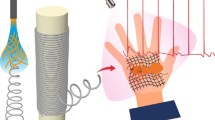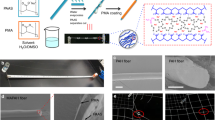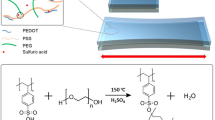Abstract
Stretchable color-changing fibers are urgently demanded for smart textiles/clothing due to their perfect implantability, permeability of vapor and heat, and flexibility/ stretchability. Herein, stretchable electrothermochromic fibers were fabricated with unconventional stretchable conductive fibers as core layers and thermochromic coatings as shell layers. In the stretchable conductive fibers, hierarchical porous structures with percolative one-dimensional (1D) conductive networks were constructed through phase inversion of carbon nanotube/polyurethane (CNT/PU) solutions. With the deposition of silver nanoparticles (AgNPs) on the surface of micro-pores, electrically conductive dual-pathways consisting of 0D AgNPs and 1D CNTs were formed to significantly enhance the electric conductivity and thus improve the electrothermal performance of the fibers. More importantly, because of the connective CNTs and AgNPs, such dual-pathways ensured the electron transport under the stretching state, preventing the sharp decay of conductivity and electrothermal performance. Through the continuous wet-spinning method, the stretchable conductive fibers can be easily obtained with the length up to several meters. At last, stretchable electrothermochromic fibers were prepared with two color-changing modes and implanted into textile perfectly, advancing their applications in wearable display and military adaptive camouflage of smart clothing.
摘要
可拉伸变色纤维具有良好的服装植入性、 透气透热性、 柔性和可拉伸性. 因此, 目前对于可拉伸变色纤维的研究受到广泛关注. 本文以导电纤维为芯层、 热致变色涂层为壳层, 制备了可拉伸电热致变色纤维. 通过相转换法, 在聚氨酯基体中构建了一维导电碳纳米管(CNTs)网络的分级多孔结构. 通过在微孔表面沉积银纳米颗粒(AgNPs), 使可拉伸导电纤维内形成AgNPs和CNTs的导电双路径, 从而有效提高了纤维的电导率和电热性能, 保证了电子的**常传输, 有效避免了纤维在拉伸状态下电导率的急剧衰减. 此外, 通过连续的湿法纺丝方法可制备长达几米的可拉伸导电纤维. 涂覆热致变色涂层后, 所制备的电热致变色纤维可完美地植入到织物中进行多种图案的编织, 并实现多种颜色变化, 在可穿戴显示、 自适应伪装等智能服装领域具有广阔的应用前景.
Similar content being viewed by others
References
House DH, Breen DE. Cloth Modeling and Animation. Boca Raton: AK Peters Ltd./CRC Press, 2000
Chae S, Park H, Yoon J, et al. Polydiacetylene supramolecules in electrospun microfibers: Fabrication, micropatterning, and sensor applications. Adv Mater, 2007, 19: 521–524
Cai L, Peng Y, Xu J, et al. Temperature regulation in colored infrared-transparent polyethylene textiles. Joule, 2019, 3: 1478–1486
Gao HL, Zhao R, Cui C, et al. Bioinspired hierarchical helical nanocomposite macrofibers based on bacterial cellulose nanofibers. Natl Sci Rev, 2020, 7: 73–83
Ma T, Gao HL, Cong HP, et al. A bioinspired interface design for improving the strength and electrical conductivity of graphene-based fibers. Adv Mater, 2018, 30: 1706435
Ge J, Sun L, Zhang FR, et al. A stretchable electronic fabric artificial skin with pressure-, lateral strain-, and flexion-sensitive properties. Adv Mater, 2016, 28: 722–728
Woo J, Lee H, Yi C, et al. Ultrastretchable helical conductive fibers using percolated Ag nanoparticle networks encapsulated by elastic polymers with high durability in omnidirectional deformations for wearable electronics. Adv Funct Mater, 2020, 1910026
Lee S, Shin S, Lee S, et al. Ag nanowire reinforced highly stretchable conductive fibers for wearable electronics. Adv Funct Mater, 2015, 25: 3114–3121
Fu X, Li Z, Xu L, et al. Amphiphilic core-sheath structured composite fiber for comprehensively performed supercapacitor. Sci China Mater, 2019, 62: 955–964
Wu X, Peng H. Polymer-based flexible bioelectronics. Sci Bull, 2019, 64: 634–640
Hong Y, Cheng XL, Liu GJ, et al. One-step production of continuous supercapacitor fibers for a flexible power textile. Chin J Polym Sci, 2019, 37: 737–743
Lu X, Zhang Z, Sun X, et al. Flexible and stretchable chromatic fibers with high sensing reversibility. Chem Sci, 2016, 7: 5113–5117
Khudiyev T, Hou C, Stolyarov AM, et al. Sub-micrometer surface-patterned ribbon fibers and textiles. Adv Mater, 2017, 29: 1605868
** Y, Lin Y, Kiani A, et al. Materials tactile logic via innervated soft thermochromic elastomers. Nat Commun, 2019, 10: 4187
Huang G, Liu L, Wang R, et al. Smart color-changing textile with high contrast based on a single-sided conductive fabric. J Mater Chem C, 2016, 4: 7589–7594
Gauvreau B, Guo N, Schicker K, et al. Color-changing and color-tunable photonic bandgap fiber textiles. Opt Express, 2008, 16: 15677–15693
Günay M. Eco-Friendly Textile Dyeing and Finishing. Rijeka: InTech, 2013
Hunger K. Industrial Dyes: Chemistry, Properties, Applications. Weinheim: Wiley-VCH, 2002
Yoon B, Ham DY, Yarimaga O, et al. Inkjet printing of conjugated polymer precursors on paper substrates for colorimetric sensing and flexible electrothermochromic display. Adv Mater, 2011, 23: 5492–5497
Shi R, Lou Z, Chen S, et al. Flexible and transparent capacitive pressure sensor with patterned microstructured composite rubber dielectric for wearable touch keyboard application. Sci China Mater, 2018, 61: 1587–1595
Sun X, Zhang J, Lu X, et al. Mechanochromic photonic-crystal fibers based on continuous sheets of aligned carbon nanotubes. Angew Chem Int Ed, 2015, 54: 3630–3634
Pu J, Wang X, Xu R, et al. Highly stretchable microsupercapacitor arrays with honeycomb structures for integrated wearable electronic systems. ACS Nano, 2016, 10: 9306–9315
Jia R, Li L, Ai Y, et al. Self-healable wire-shaped supercapacitors with two twisted NiCo2O4 coated polyvinyl alcohol hydrogel fibers. Sci China Mater, 2018, 61: 254–262
Zhou Y, Fang J, Wang H, et al. Multicolor electrochromic fibers with helix-patterned electrodes. Adv Electron Mater, 2018, 4: 1800104
Kinashi K, Suzuki T, Yasunaga H, et al. Carrier-assisted dyeing of poly(L-lactic acid) fibers with dispersed photochromic spiropyran dyes. Dyes Pigments, 2017, 145: 444–450
Yuan W, Li Q, Zhou N, et al. Structural color fibers directly drawn from colloidal suspensions with controllable optical properties. ACS Appl Mater Interfaces, 2019, 11: 19388–19396
Shang S, Liu Z, Zhang Q, et al. Facile fabrication of a magnetically induced structurally colored fiber and its strain-responsive properties. J Mater Chem A, 2015, 3: 11093–11097
Pinto TV, Cardoso N, Costa P, et al. Light driven PVDF fibers based on photochromic nanosilica@naphthopyran fabricated by wet spinning. Appl Surf Sci, 2019, 470: 951–958
Shang S, Zhang Q, Wang H, et al. Facile fabrication of magnetically responsive PDMS fiber for camouflage. J Colloid Interface Sci, 2016, 483: 11–16
Pinto TV, Fernandes DM, Guedes A, et al. Photochromic polypropylene fibers based on UV-responsive silica@phosphomolybdate nanoparticles through melt spinning technology. Chem Eng J, 2018, 350: 856–866
Li K, Shao Y, Yan H, et al. Lattice-contraction triggered synchronous electrochromic actuator. Nat Commun, 2018, 9: 4798
Li K, Zhang Q, Wang H, et al. Red, green, blue (RGB) electrochromic fibers for the new smart color change fabrics. ACS Appl Mater Interfaces, 2014, 6: 13043–13050
Li Q, Li K, Fan H, et al. Reduced graphene oxide functionalized stretchable and multicolor electrothermal chromatic fibers. J Mater Chem C, 2017, 5: 11448–11453
Zhou Y, Zhao Y, Fang J, et al. Electrochromic/supercapacitive dual functional fibres. RSC Adv, 2016, 6: 110164
Sukitpaneenit P, Chung TS. Molecular elucidation of morphology and mechanical properties of PVDF hollow fiber membranes from aspects of phase inversion, crystallization and rheology. J Membrane Sci, 2009, 340: 192–205
Acknowledgements
This work was supported by the National Natural Science Foundation of China (51672043), Donghua University Distinguished Young Professor Program (LZB2019002), Young Elite Scientists Sponsorship Program by China Association for Science and Technology (2017QNRC001), and the Fundamental Research Funds for the Central Universities (CUSF-DH-D-2018006).
Author information
Authors and Affiliations
Contributions
Author contributions Li K, Fan H, and Li Q conceived the project; Fan H and Li Q carried out the preparation and measurement of stretchable electrothermochromic fibers; Wang H, Hou C, Zhang Q and Li Y assisted the result analysis; Fan H, Li K and Wang H co-wrote the manuscript.
Corresponding authors
Ethics declarations
Conflict of interest The authors declare that they have no conflict of interest.
Additional information
Hongzhi Wang joined the College of Material Science and Engineering in Donghua University as a full professor in 2005. Before that, he completed his postdoc research at the National Institute of Advanced Industrial Science and Technology (AIST), Japan. In recent years, he leads a research group at Donghua University and pursues to construct various flexible multifunctional devices, including flexible optoelectronic devices, artificial muscles and flexible energy sources/systems for smart textiles/clothing.
Supporting Information
40843_2020_1404_MOESM1_ESM.pdf
Stretchable Electrothermochromic Fibers Based on Hierarchical Porous Structures with Electrically Conductive Dual-Pathways
Rights and permissions
About this article
Cite this article
Fan, H., Li, Q., Li, K. et al. Stretchable electrothermochromic fibers based on hierarchical porous structures with electrically conductive dual-pathways. Sci. China Mater. 63, 2582–2589 (2020). https://doi.org/10.1007/s40843-020-1404-y
Received:
Accepted:
Published:
Issue Date:
DOI: https://doi.org/10.1007/s40843-020-1404-y




